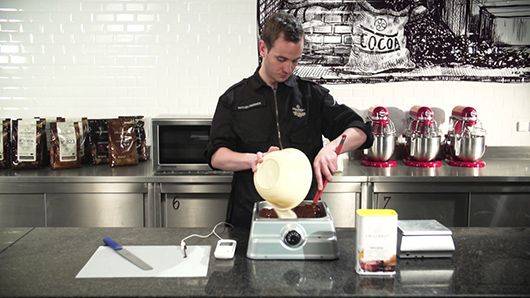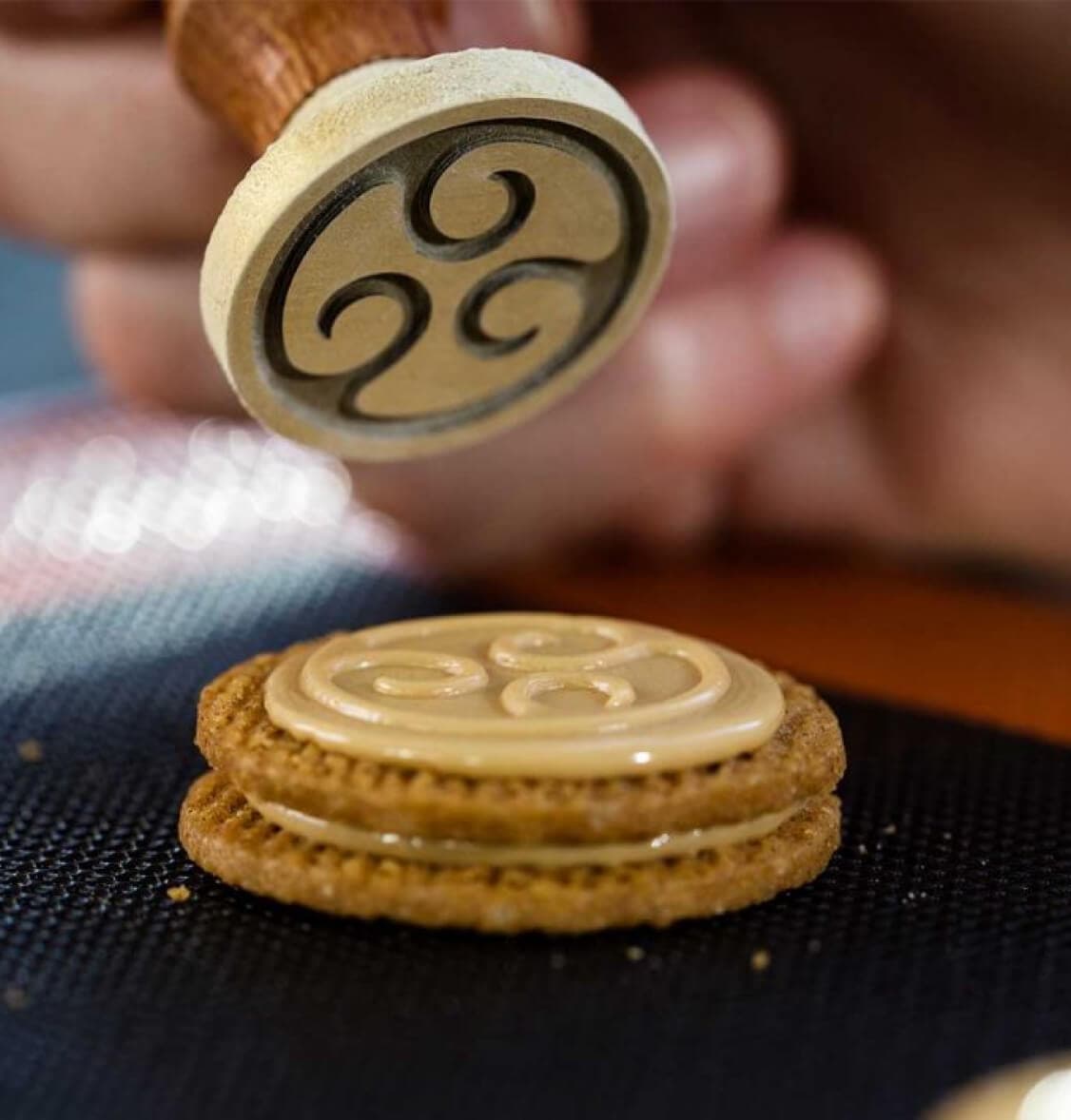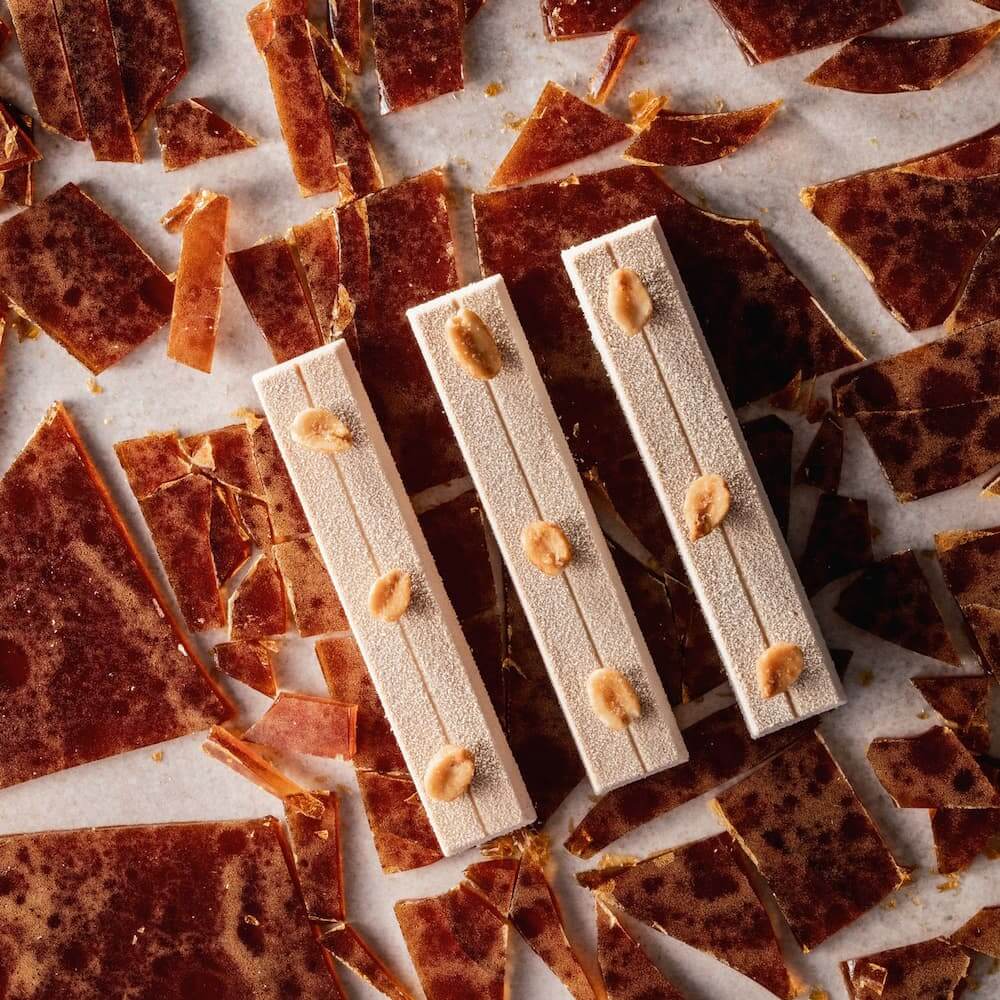
Mycryo is gekristalliseerde cacaoboter in poedervorm. Deze handleiding legt uit hoe u uw chocolade hier eenvoudig mee kunt tempereren of voorkristalliseren.
GOED OM TE WETEN
Waarom is vloeibaarheid zo belangrijk?
De vloeibaarheid van uw chocolade bepaalt de dikte van de schelp en de beet van uw chocoladeproducten: hoe vloeibaarder uw chocolade, hoe dunner en knapperiger de schelp zal zijn.
Als u chocolade met de juiste vloeibaarheid gebruikt, bespaart u ook tijd: u kunt grote moulures in één keer gieten met minder vloeibare chocolade. Chocolade met een hogere vloeibaarheid is beter voor moulures met veel details, maar u zult uw moulure 2 of 3 keer moeten vullen met chocolade.
Waarom is het zo belangrijk om chocolade correct voor te kristalliseren?
Het helpt om de chocolade hard te laten worden en zorgt voor een mooie satijnglans en een heerlijke beet. Het zorgt ervoor dat de chocolade krimpt tijdens het afkoelen, waardoor u hem gemakkelijker uit de moulure kunt halen. Slecht gekristalliseerde of niet-gekristalliseerde chocolade wordt grijs en heeft geen smakelijke glans.
Wat is tempereren of voorkristalliseren?
Als chocolade wordt getempereerd, dan is het de bedoeling om de cacaoboter voor te kristalliseren. Dat is belangrijk als u uw chocolade klaarmaakt om te verwerken. Tijdens het tempereren neemt de cacaoboter in de chocolade een stabiele kristalheldere vorm aan. Dat garandeert een perfect afgewerkt product met een satijnglans en harde beet. Het zorgt er ook voor dat de chocolade krimpt tijdens het afkoelen, waardoor u hem gemakkelijker uit de moulure kunt halen. Als chocolade gewoon wordt gesmolten (tussen 40 en 45 °C) en u hem daarna laat afkoelen tot een gepaste werktemperatuur, dan zal het afgewerkt product niet glanzen. Als u een kleine inspanning levert om uw chocolade op een correcte manier op de juiste werktemperatuur te brengen, dan krijgt u gegarandeerd het gewenste eindresultaat. En dat is wat we bedoelen met temperen: chocolade naar de juiste werktemperatuur brengen terwijl u ervoor zorgt dat de kristalstructuur van de cacaoboter erin stabiel blijft. Hieronder ontdekt u dat de drie basisprincipes om correct te temperen tijd, temperatuur en beweging zijn.
Stap 1
Smelt uw chocolade op 40-45 °C (in een magnetron of bain-marie).
Stap 2
Zorg ervoor dat de chocolade op kamertemperatuur afkoelt tot 34 °C (voor donkere chocolade) of 33 °C (voor witte, gekleurde of melkchocolade).
Stap 3
Voeg 1% Mycryo toe aan uw gesmolten chocolade, d.w.z. 10 g per kilo chocolade.
Stap 4
Goed mixen.
Stap 5
Als de chocolade perfect is voorgekristalliseerd, hou hem dan op 34 °C (voor donkere chocolade) of 33 °C (voor witte, gekleurde of melkchocolade).
Stap 6
Om uw chocolade gedurende langere tijd te kunnen gebruiken, bewaart u hem op 31 °C (voor donkere chocolade) of 29 °C (voor witte, gekleurde of melkchocolade).
En de technische kant van het verhaal?
Als u uw chocolade tempereert op een marmeren werkblad of door er voorgekristalliseerde chocolade in te strooien, dan veroorzaakt u een kettingreactie die ervoor zorgt dat de cacaoboter in uw chocolade een stabiele kristalstructuur aanneemt die we de betakristalvorm noemen. Cacaoboter kan in 6 verschillende vormen kristalliseren, maar het is de betakristalvorm die zorgt voor de gewenste kwaliteiten die van de chocolade het aantrekkelijke product maken dat uw klanten kennen: een mooie glans en stevige beet. Met deze nieuwe tempereertechniek creëert u de betakristalvorm niet, u voegt hem gewoon toe. Amper 1% Mycryo bevat net genoeg betakristallen om de kettingreactie op te starten die zorgt voor een perfecte kristallisering. Zo krijgt u meer tijd om uw chocolade te bewerken aangezien u al van bij het begin het proces stuurt.

Hulp nodig bij je chocolade assortiment?
- Find troubleshooting guides & tutorials
- Chat live with an advisor chef and find the right solution to your challenges



Comments